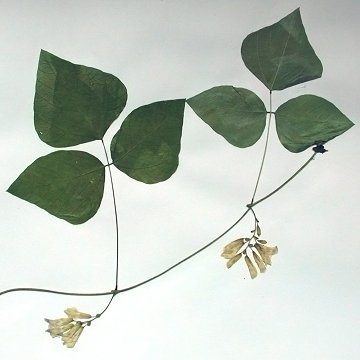

Amphicarpaea bracteata - (image 1 of 5)
Taxonomy
Family: Fabaceae
Habitat
Woodlands. Disturbance adapted, often forming large colonies in rich soils.
Associates
Distribution
Quebec and Nova Scotia west to Manitoba and MT, south to FL and TX.
Morphology
Twining annual to 1.5 m. Leaves alternate on long petioles, 3-pinnate, the terminal petiolule longer than the laterals, ovate to deltoid, tip acuminate. Flowers 2-several on auxiliary puduncles; petals white to pale blue-violet 12-18 mm. Fruit a legume to 4 cm long.
Notes
Flowers July to September
Wetland Indicator: Facultative
Superficially resembles poison ivy. In addition to the attractive above-ground flowers, this plant produces petal-less, subterranean flowers near the base of the plant that give rise to a fleshy single-seeded pod. The subterranean pods are edible if boiled to remove the hull and eaten like a nut.
References
Gleason, Henry A.
and A. Cronquist. 1991. Manual of Vascular Plants of Northeastern United States
and Adjacent Canada. Second Ed.
The New York Botanical Garden. Bronx, NY
Peterson, L. A. 1977. A Field Guide to Edible Wild Plants: Eastern and central North America.
Houghton Mifflin Company. New York, NY
Swink, F. and G.
Wilhelm. 1994. Plants of the Chicago Region.
Indiana Academy of Science. The Morton Arboretum. Lisle, Illinois.
|
© Michael Hough 2004 |